You can grow several powerful anxiety-relieving herbs right in your indoor garden. Lavender promotes relaxation and better sleep, while lemon balm helps reduce stress and improve mood. Holy basil (tulsi) acts as a natural adaptogen to balance stress hormones, and chamomile offers gentle calming effects perfect for evening tea. Other effective options include peppermint for mental clarity, rosemary for focus, and passion flower for easing nervous tension. These herbs thrive in containers with proper sunlight and well-draining soil, making them ideal for indoor growing. Discover how a few simple growing techniques can transform your space into a calming herbal sanctuary.
Benefits of Indoor Herb Gardens
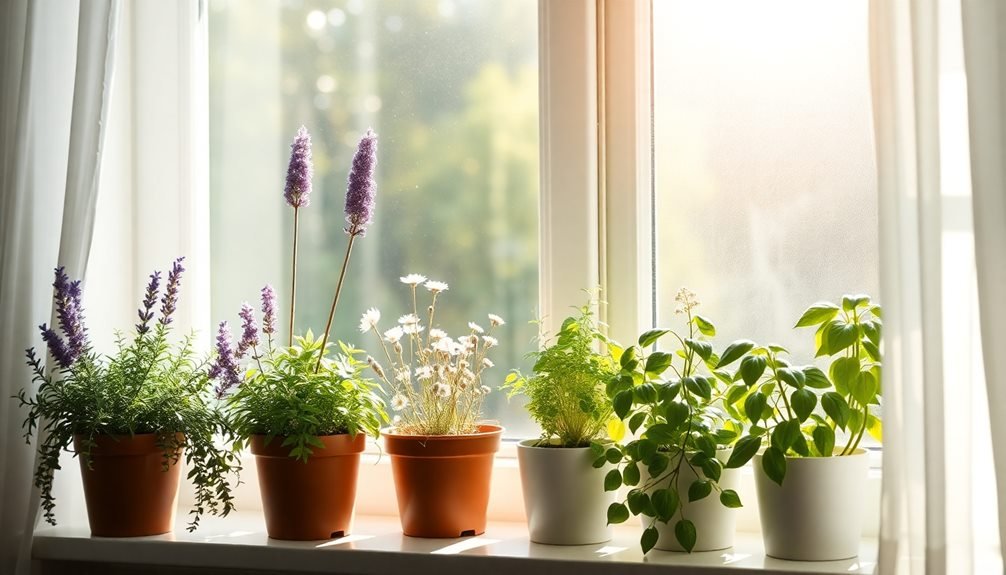
Growing your own indoor herb garden brings multiple advantages for those seeking natural anxiety relief. You'll have immediate access to fresh, organic herbs whenever anxiety strikes, eliminating the need to rely on store-bought alternatives that may contain preservatives or lose potency during storage. The act of tending to your herbs can itself become a calming ritual, providing a mindful escape from daily stressors.
Indoor herb gardens also purify your air naturally, as plants filter out common indoor pollutants and release oxygen, creating a healthier living environment. You'll save money by growing your own herbs instead of repeatedly purchasing pre-packaged varieties, and you'll know exactly how your plants have been grown and handled.
The visual appeal of green, thriving plants can boost your mood and reduce stress levels, while the fresh scents of aromatic herbs like lavender and mint can provide instant aromatherapy benefits. Additionally, you don't need much space – even a small windowsill garden can yield enough herbs for regular use.
You'll also have the satisfaction of harvesting your own natural medicine, connecting you more deeply to the healing process.
Setting Up Your Anxiety Garden
Starting your anxiety-relief herb garden begins with selecting a bright windowsill or peaceful corner that's easily accessible and provides adequate natural light.
You'll need containers with proper drainage holes and well-draining potting soil to guarantee your herbs thrive and don't develop root rot.
Proper air circulation and consistent temperatures between 65-70°F will help your anxiety-fighting herbs flourish, so keep them away from drafty areas and heating vents.
Choose the Right Location
Successful herb gardens for anxiety relief depend heavily on proper location selection. You'll want to choose spots that receive adequate sunlight, maintain proper airflow, and stay within ideal temperature ranges for your calming herbs to thrive.
Most anxiety-relieving herbs need 6-8 hours of direct sunlight daily. If you're growing indoors, place your garden near south-facing windows or supplement with grow lights. Keep your herbs away from drafty areas and heat sources that could stress the plants.
| Location Type | Benefits | Considerations |
|---|---|---|
| Windowsill | Natural light, easy access, space-saving | Temperature fluctuations, limited space |
| Kitchen Counter | Convenient for use, controlled environment | May need grow lights, moisture control |
| Dedicated Plant Room | Ideal growing conditions, expandable | Requires more setup, dedicated space |
Consider humidity levels in your chosen location. Most herbs prefer 40-60% humidity. If your space is too dry, use a humidity tray or small humidifier. Remember, stressed plants produce fewer therapeutic compounds, so selecting the right location from the start guarantees your anxiety garden delivers maximum benefits.
Essential Container Growing Tips
When setting up your anxiety herb garden, proper containers make all the difference in your plants' health and energy. Choose containers at least 6-8 inches deep with adequate drainage holes to prevent root rot.
If you're reusing old pots, thoroughly clean them with a 10% bleach solution to eliminate harmful pathogens.
Fill your containers with high-quality potting mix specifically designed for herbs. Don't use garden soil, as it's too heavy and may harbor diseases. Leave about an inch of space at the top of each pot for watering and mulching.
Consider adding a layer of pebbles or broken pottery at the bottom to improve drainage.
Match your container size to your herbs' growth habits. Compact herbs like thyme and chamomile thrive in 6-inch pots, while larger varieties like lavender need 12-inch containers.
If you're combining multiple herbs in one pot, make sure they've similar water and light requirements.
Place saucers under your containers to protect surfaces, but don't let water accumulate in them.
Consider self-watering containers if you tend to forget regular watering, as consistent moisture is essential for healthy herb growth.
Proper Lighting and Ventilation
Light and air circulation form the foundation of a thriving anxiety herb garden. Most anxiety-reducing herbs need at least 6-8 hours of sunlight daily, so place your containers near south-facing windows when possible.
If you don't have adequate natural light, invest in LED grow lights positioned 6-12 inches above your plants, running them for 12-14 hours daily.
Your herbs will also need proper ventilation to prevent mold growth and strengthen their stems. Set up a small fan to create gentle air movement, or open nearby windows for a few hours each day.
Don't place herbs directly in front of air vents or in drafty areas, as this can dry them out too quickly.
Monitor your plants' response to light conditions. If you notice leggy growth or pale leaves, they need more light. Conversely, if leaves show brown spots or appear bleached, they're getting too much direct sun.
You'll know your ventilation is working when you can gently brush your herbs and smell their aromatic oils – this means they're producing the compounds that help reduce anxiety.
Adjust light and airflow accordingly to maintain ideal growing conditions.
Calming Lavender Growing Tips
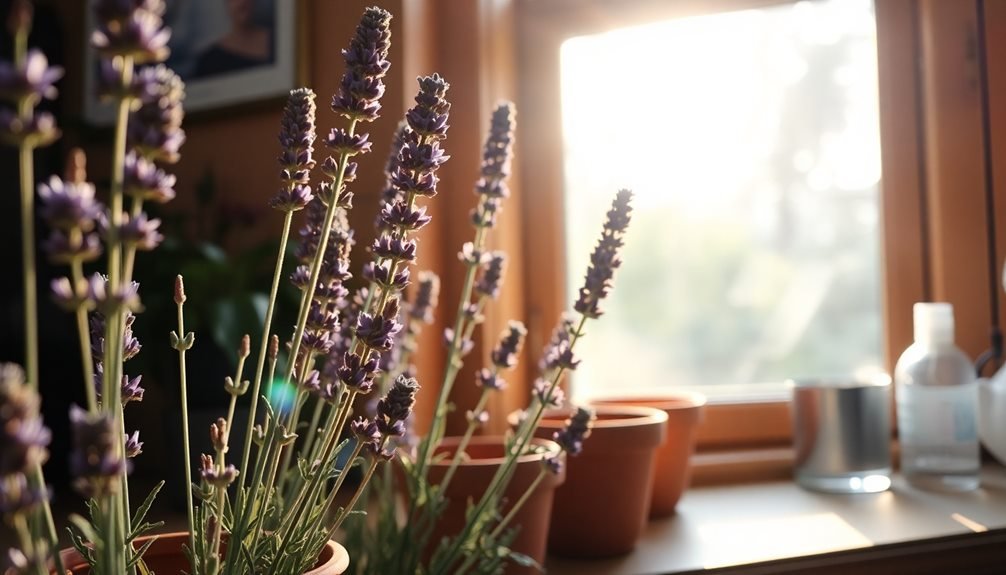
Growing lavender successfully requires careful attention to soil drainage and sunlight exposure. You'll need to plant your lavender in well-draining potting soil mixed with sand or perlite, as waterlogged roots will quickly kill the plant.
Place your container in a spot that receives at least 6 hours of direct sunlight daily, preferably near a south-facing window.
Water your lavender sparingly, allowing the soil to dry out between waterings. You'll know it's time to water when the top inch of soil feels dry to the touch. During winter, reduce watering even further to prevent root rot.
Maintain temperatures between 65-70°F (18-21°C), and guarantee good air circulation around the plant.
Prune your lavender regularly to maintain its shape and promote bushy growth. In early spring, cut back about one-third of the plant, being careful not to cut into woody stems.
You can harvest the flowers when they're in full bloom by cutting the stems just above the leaves. Dry the blooms for use in teas, sachets, or aromatherapy.
Remember that indoor lavender won't grow as large as outdoor plants, but with proper care, it'll still provide calming benefits.
Growing Lemon Balm Indoors
Unlike lavender, lemon balm thrives in partial shade and adapts well to indoor conditions. To grow this calming herb indoors, you'll need a container at least 6 inches deep with drainage holes, well-draining potting soil, and a spot that receives 4-6 hours of indirect sunlight daily.
Plant your lemon balm seeds ¼ inch deep in moistened soil, or transplant a small starter plant. Keep the soil consistently moist but not waterlogged, and maintain room temperatures between 65-70°F. You'll notice the plant's square stems and heart-shaped leaves emerging within 10-14 days if growing from seed.
Once your lemon balm reaches 6-8 inches tall, pinch back the growing tips to encourage bushier growth. The plant can spread quickly, so you'll want to trim it regularly. Harvest leaves before the plant flowers for the best flavor and medicinal properties. Don't take more than ⅓ of the plant at once to guarantee healthy regrowth.
If you notice yellowing leaves, reduce watering frequency. For pest control, inspect the undersides of leaves weekly for spider mites and whiteflies, which can be removed with a gentle spray of water.
Chamomile Care and Cultivation
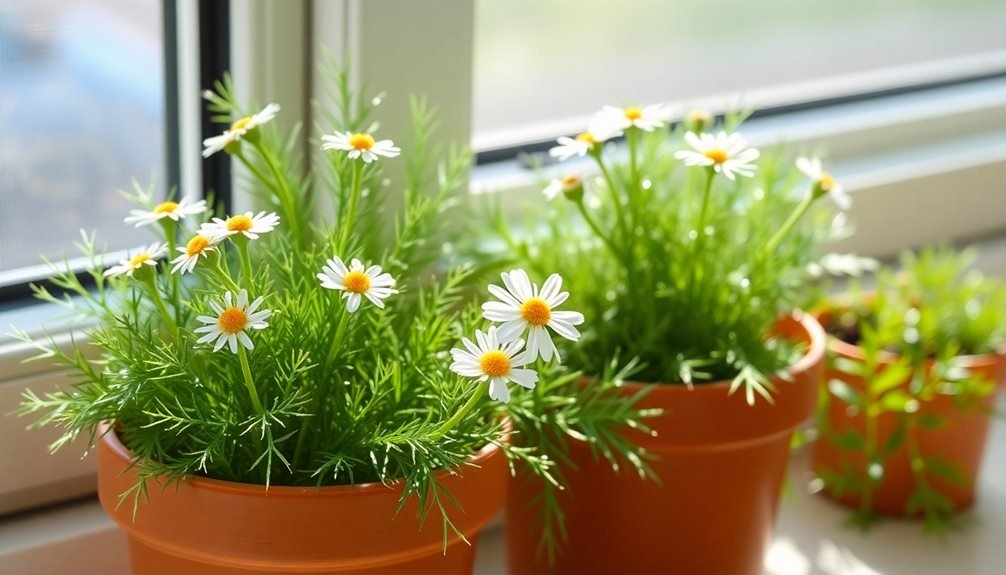
Through proper care, both German and Roman chamomile varieties can thrive in your garden or containers.
You'll need well-draining soil, moderate watering, and at least six hours of sunlight daily. German chamomile grows as an annual, reaching heights of 24 inches, while Roman chamomile spreads as a perennial ground cover, growing only 4-12 inches tall.
Start your chamomile indoors 6-8 weeks before the last frost date. Sow seeds 1/4 inch deep in seed-starting mix, keeping soil consistently moist until germination occurs in 7-14 days.
Once seedlings develop their second set of true leaves, thin them to 6 inches apart. If growing in containers, choose pots at least 12 inches deep with drainage holes.
You'll know it's time to harvest when the flower petals begin falling back from the center. Pick flowers in the morning after dew has dried but before the heat of the day.
Dry them immediately by spreading them on screens in a warm, dark place with good air circulation. Store dried flowers in an airtight container away from direct light for up to a year.
Holy Basil Growing Guide
Growing holy basil (Ocimum sanctum) at home lets you maintain a steady supply of this anxiety-relieving herb, as it needs full sun, well-draining soil, and consistent moisture to thrive.
You'll find it easy to start holy basil from seeds or cuttings in spring, keeping the soil temperature around 70°F for ideal germination and growth.
Once your plants are established, harvest the leaves regularly before flowering occurs, and dry them in a well-ventilated area or freeze them in airtight containers to preserve their medicinal properties.
Holy Basil Growing Requirements
When starting your holy basil garden, you'll need well-draining soil with a pH between 6.0 and 7.5.
Add organic matter to improve drainage and fertility, guaranteeing your plants receive adequate nutrients throughout their growing cycle.
Holy basil thrives in full sun, requiring 6-8 hours of direct sunlight daily.
You can grow it indoors near a south-facing window or under grow lights.
Maintain temperatures between 65-85°F (18-29°C), as the plant isn't frost-tolerant.
Water your holy basil when the top inch of soil feels dry.
Don't overwater, as soggy conditions can lead to root rot.
You'll need to water more frequently during summer months and less in winter.
Maintain moderate humidity levels around 40-50%.
Feed your plants with a balanced organic fertilizer every 4-6 weeks during the growing season.
Prune regularly to encourage bushier growth and prevent flowering, which can make the leaves bitter.
If you're growing in containers, choose pots at least 12 inches deep with drainage holes.
Space multiple plants 12-18 inches apart to guarantee proper air circulation and prevent disease.
Planting and Propagation Tips
Starting from seeds or cuttings, holy basil can be propagated successfully with the right timing and technique.
To grow from seeds, sow them 1/4 inch deep in well-draining potting soil during early spring. You'll see germination within 5-10 days when maintaining soil temperatures between 70-75°F. Space multiple plants 12-18 inches apart to allow proper air circulation.
For propagation from cuttings, select healthy stems 4-6 inches long with no flowers. Remove the lower leaves and place the cutting in a glass of water or directly into moist potting soil. You'll notice root development within 2-3 weeks. Once roots are established, transplant the cutting into a permanent container.
When transplanting seedlings or rooted cuttings, choose a pot at least 6 inches deep with drainage holes. Fill with organic potting mix and plant at the same depth as the original container. Water thoroughly but don't saturate.
You can also direct-sow seeds outdoors after the last frost, but indoor starting gives you better control over growing conditions. Whether starting from seeds or cuttings, maintain consistent moisture until plants are established.
Harvest and Storage Methods
The ideal time to harvest holy basil leaves arrives just before the plant flowers, when essential oil concentrations peak. You'll know it's time when the stems have grown to about 6-8 inches tall. Cut the stems about 6 inches from the ground, leaving at least two pairs of leaves on the plant to encourage regrowth.
To harvest, gather stems in small bundles early in the morning after the dew has dried but before the day's heat sets in. Use clean, sharp scissors to make clean cuts, which helps prevent disease and promotes healing.
Don't remove more than one-third of the plant at once to guarantee continued growth.
For storage, you've got several options. You can dry the leaves by hanging bundles upside down in a warm, dark, well-ventilated area for 1-2 weeks. Once dried, remove the leaves from the stems and store them in an airtight container away from light.
Alternatively, freeze fresh leaves by placing them in freezer bags or blend them with water in ice cube trays. For immediate use, store fresh leaves wrapped in damp paper towels in the refrigerator for up to a week.
Peppermint for Peace and Calm
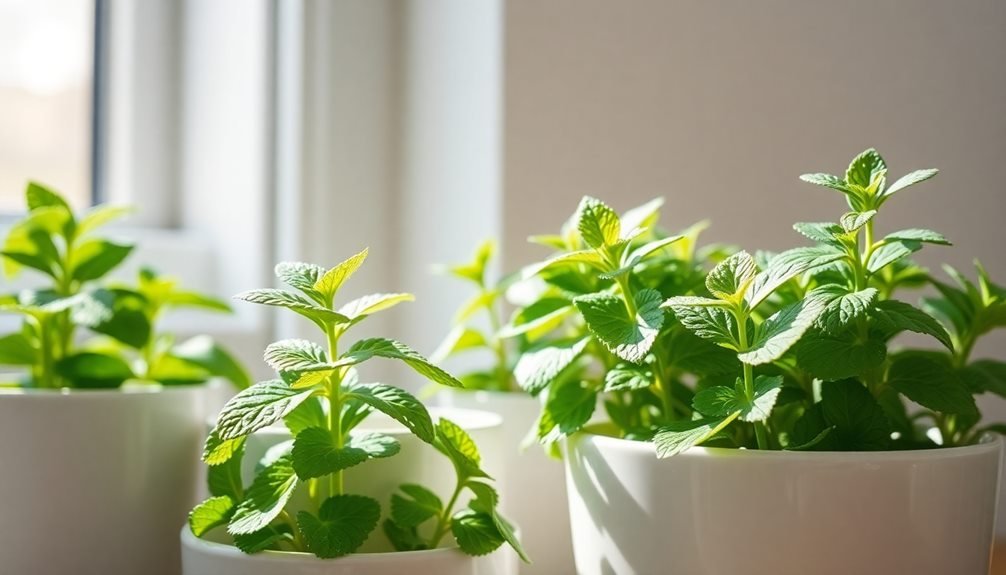
Countless people have discovered peppermint's remarkable ability to soothe anxiety and promote relaxation. You'll find this versatile herb can ease your mind through multiple methods – as a tea, essential oil, or even fresh leaves added to water. The menthol in peppermint triggers a cooling sensation that naturally helps your body and mind unwind.
To harness peppermint's calming effects, you can grow it easily in your indoor garden. Place your peppermint plant in a sunny window and keep the soil consistently moist. You'll notice it grows vigorously, so don't hesitate to harvest leaves regularly. For tea, steep 1-2 teaspoons of fresh leaves in hot water for 5-10 minutes.
If you're feeling particularly anxious, try crushing fresh peppermint leaves and inhaling their aroma directly. The scent stimulates your limbic system, which controls emotions and behavior.
You can also add a few drops of peppermint essential oil to your diffuser or bath water. For the best results, incorporate peppermint into your daily routine, whether it's morning tea or an evening aromatherapy session.
Rosemary as Natural Stress Relief
Like peppermint, rosemary stands out as a powerful herb for managing anxiety, but with its own unique calming properties. When you're feeling stressed, this aromatic herb can help reduce cortisol levels and improve your mental clarity.
You'll find that rosemary's active compounds, particularly rosmarinic acid and carnosic acid, work together to combat anxiety while boosting your cognitive function.
To benefit from rosemary's calming effects, you can grow it easily in your indoor garden. Place your rosemary plant in a sunny window where it'll receive at least six hours of direct sunlight daily.
You'll want to keep the soil slightly dry between waterings, as this Mediterranean herb doesn't tolerate wet feet. Once established, you can harvest sprigs regularly to make tea, add to aromatherapy diffusers, or create calming sachets for your pillow.
Research shows that even inhaling rosemary's scent can lower anxiety levels and improve mood within minutes.
You'll get the most benefit by combining regular rosemary use with mindful breathing exercises. Try crushing a few fresh leaves between your fingers and taking deep breaths when you're feeling overwhelmed.
Sage Cultivation Methods
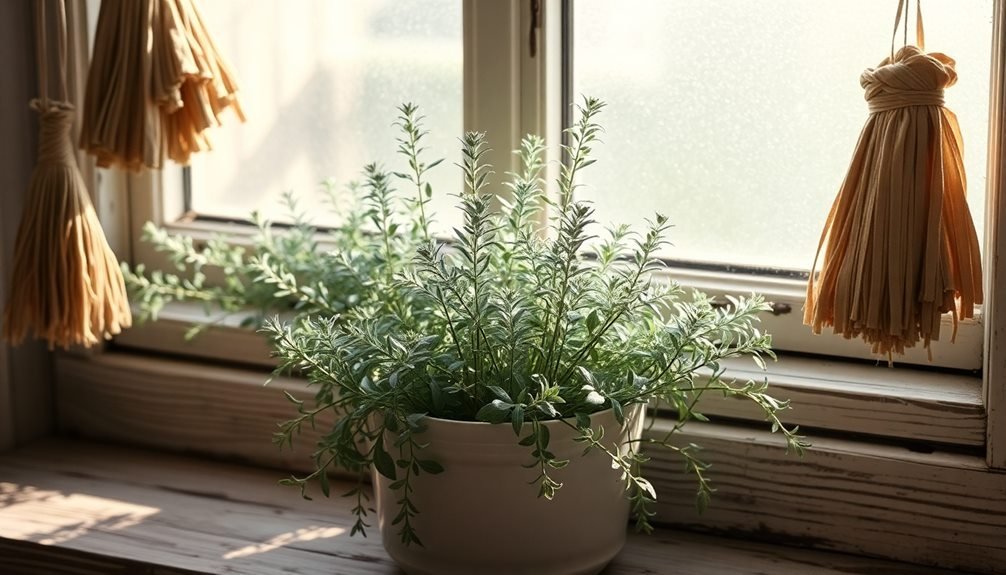
Growing sage successfully requires careful attention to its specific environmental needs. You'll want to start with well-draining soil and place your sage plant where it'll receive at least 6 hours of direct sunlight daily. Indoor temperatures between 60-70°F provide ideal growing conditions for this anxiety-reducing herb.
| Care Element | Specific Requirements |
|---|---|
| Watering | Water when top inch is dry |
| Light | 6-8 hours direct sunlight |
| Soil pH | 6.0-7.0 |
To cultivate sage indoors, you'll need a container at least 8 inches deep with drainage holes. Don't overwater your sage plant; it's drought-tolerant and prefers slightly dry conditions. You can propagate sage through cuttings or seeds, though cuttings typically yield stronger plants.
Prune your sage regularly to maintain its shape and encourage bushier growth. When harvesting, don't take more than 2/3 of the plant at once. It's best to trim in the morning after the dew has dried but before the day heats up. Remember to pinch off any flowers that appear during the first year to direct energy toward leaf production.
Passion Flower Indoor Care
While sage thrives in drier conditions, passion flower requires a more tropical approach to indoor care. You'll need to create a humid environment and provide sturdy support for this climbing vine to flourish indoors.
Position your passion flower near a south-facing window where it can receive 4-6 hours of bright, indirect sunlight daily.
To successfully grow passion flower indoors, follow these essential care requirements:
- Maintain soil moisture by watering when the top inch feels dry, but guarantee proper drainage to prevent root rot. Use a well-draining potting mix enriched with organic matter.
- Keep humidity levels between 60-80% by misting regularly or using a humidity tray filled with pebbles and water.
- Support the vine's growth with a trellis or wire frame that's at least 4 feet tall, training the tendrils as they grow.
- Feed your passion flower monthly during growing season with a balanced, water-soluble fertilizer (10-10-10).
Monitor your plant for common indoor pests like spider mites and scale insects, treating promptly with neem oil if detected.
Prune back leggy growth in early spring to encourage bushier growth and more blooms.
Valerian Root Growing Basics
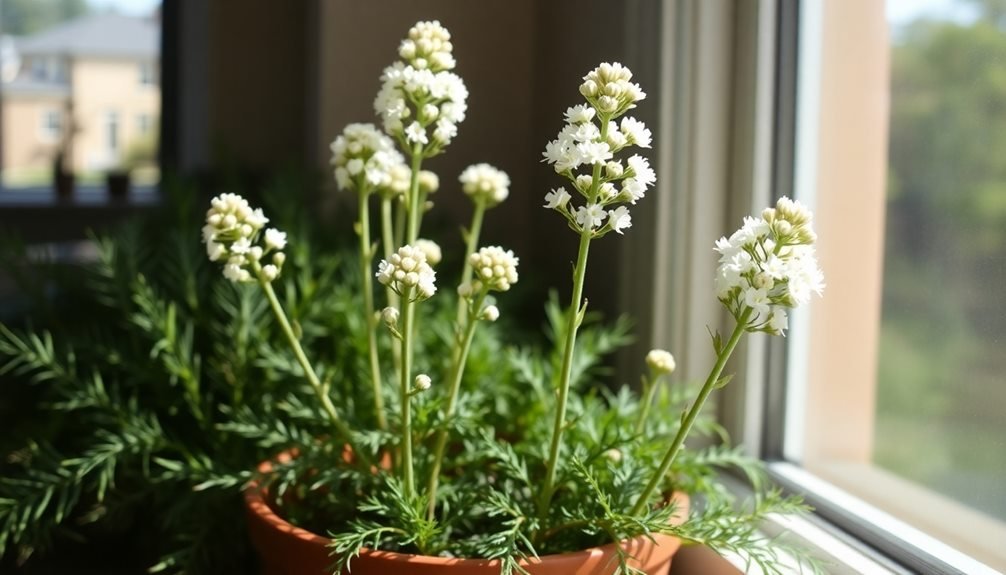
Although valerian root takes patience to establish, this perennial herb rewards growers with both medicinal benefits and delicate pink-white flowers.
You'll need to start your valerian from seed in early spring, planting them 1/4 inch deep in well-draining potting soil. Keep the soil consistently moist until germination occurs in about 2-3 weeks.
Your valerian plant requires a large container at least 12 inches deep to accommodate its extensive root system. Place it in a spot that receives 6 hours of full sun daily, though it'll tolerate partial shade.
You'll want to maintain temperatures between 65-75°F for ideal growth. Water your valerian deeply when the top inch of soil feels dry, and don't let it become waterlogged.
Add a balanced organic fertilizer monthly during the growing season. The plant will reach maturity in about 2 years, growing up to 5 feet tall.
You can harvest the roots in fall after the second year when they've developed their beneficial compounds. Cut back the foliage and carefully dig up the entire root system, leaving some roots for regrowth if you'd like the plant to continue producing.
Harvesting Your Calming Herbs
Harvest timing plays an essential role in maximizing your herbs' medicinal properties. You'll want to gather your calming herbs during the morning hours after the dew has dried but before the hot sun depletes their essential oils.
For most anxiety-relieving herbs, the best harvesting period occurs just before they flower, when their therapeutic compounds are most concentrated.
- Cut lavender stems in early summer when the buds are just beginning to show color but haven't fully opened – this guarantees the highest level of calming essential oils.
- Harvest chamomile flowers individually when they're fully open but still fresh, typically every few days throughout the growing season.
- Collect lemon balm leaves regularly throughout spring and summer, taking care not to remove more than one-third of the plant at once.
- Gather valerian roots in the fall after 2-3 years of growth, when the medicinal compounds have fully developed.
Store your freshly harvested herbs properly to preserve their anxiety-reducing properties.
Hang stems upside down in small bundles in a dark, well-ventilated area, or use a dehydrator at low temperatures to maintain their therapeutic benefits.
Daily Garden Meditation Practices
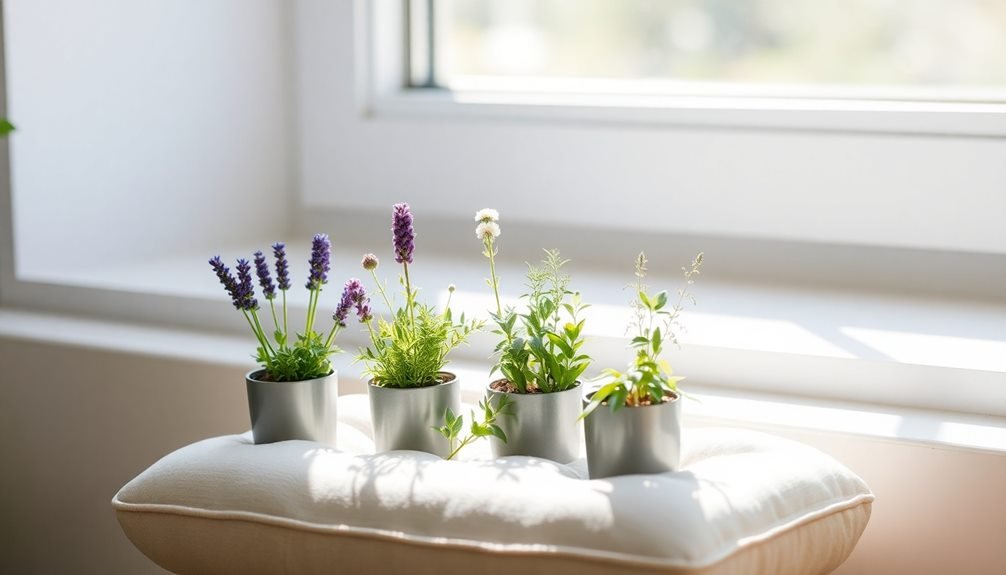
Your garden offers powerful opportunities to combine mindfulness with the healing properties of anxiety-relieving herbs.
You'll benefit from starting each morning by sitting quietly among your herbs, touching their leaves gently, and breathing in their calming aromas.
When afternoon stress builds, you can reset your mental state by returning to your garden for a brief session of pulling weeds, pruning, or simply sitting with your herbal allies.
Morning Herb Mindfulness Rituals
Starting each day with an herb-focused mindfulness ritual can transform a typical morning into a calming sensory experience. As you tend to your indoor herb garden, let each plant become a focal point for presence and awareness.
You'll find that engaging with herbs mindfully helps reduce anxiety while creating a deeper connection to nature.
Create a morning ritual by incorporating these mindful practices:
- Gently brush your fingers through lavender or rosemary leaves, inhaling deeply for 30 seconds while focusing on the aromatic oils releasing into the air.
- Harvest fresh mint or lemon balm leaves with intention, appreciating their texture and scent as you prepare morning tea.
- Mist your herbs with water, observing how each droplet catches the morning light and how the plants respond to nourishment.
- Sit quietly beside your herb garden for five minutes, noting which plants draw your attention and how their presence affects your breathing.
This daily practice combines the anxiety-reducing properties of herbs with mindfulness techniques, creating a powerful morning routine that grounds you for the day ahead.
Notice how your relationship with these plants deepens as you maintain this ritual.
Afternoon Garden Reset Practices
When afternoon stress begins to mount, stepping into your herb garden provides a natural reset for both mind and body. Take five minutes to gently touch and smell your anxiety-reducing herbs, focusing on lavender, lemon balm, and chamomile. As you interact with each plant, breathe deeply and notice their distinct aromas.
Prune your herbs mindfully during this time, removing any yellowed leaves or spent blooms. This practice helps you stay present while maintaining your plants' health. Collect the trimmed herbs in a small basket to dry for future tea blends. You'll find that this purposeful gardening activity naturally slows racing thoughts.
Create a dedicated afternoon ritual by misting your herbs with filtered water at the same time each day. Watch how water droplets collect on leaves and observe how your plants respond to care.
If you're feeling particularly stressed, gently run your fingers through rosemary or sage plants – their strong scents can help ground you in the present moment. End your practice by harvesting a few fresh leaves for an afternoon cup of calming tea, allowing the natural compounds in these herbs to support your emotional well-being.
Frequently Asked Questions
Can Anxiety-Relieving Herbs Interact Negatively With Prescription Medications?
Yes, anxiety-relieving herbs can interact with your medications. You'll need to talk with your doctor before using herbs like St. John's Wort or Valerian, as they might affect how your prescriptions work.
How Long Do These Herbs Retain Their Calming Properties After Drying?
You'll find most dried anxiety-relieving herbs maintain their potency for 6-12 months when stored properly. Keep them in airtight containers away from light and heat to preserve their calming properties longer.
Which Anxiety-Relief Herbs Are Safe for Pets in the Home?
You'll want to stick with pet-safe options like German chamomile, catnip, and lemon balm. Skip lavender and valerian, as they're toxic to cats and dogs. Always keep your herbs out of pets' reach.
Are There Specific Times of Day When Herbs Produce Stronger Calming Effects?
You'll get the strongest calming effects from herbs in the morning when they're releasing essential oils. Harvest lavender, chamomile, and other calming herbs just after the morning dew has dried for maximum potency.
Can Mixing Different Calming Herbs Together Create Adverse Reactions?
You'll need to be careful when mixing calming herbs. While most combinations are safe, some can intensify sedative effects. It's best to consult a healthcare provider before combining multiple herbs for anxiety.
In Summary
Your indoor anxiety garden can become a daily source of natural calm and healing. By growing lavender, lemon balm, chamomile, passion flower, and valerian root, you'll have fresh herbs ready whenever stress strikes. Remember to tend your plants mindfully – the very act of caring for them can soothe your nerves. Start small, be patient, and watch both your garden and your peace of mind flourish together.

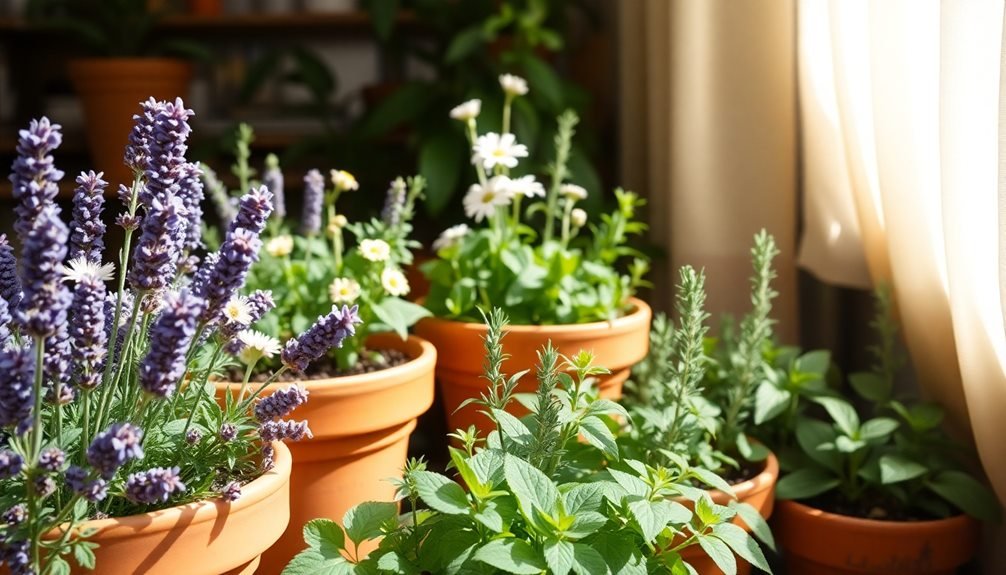



Leave a Reply